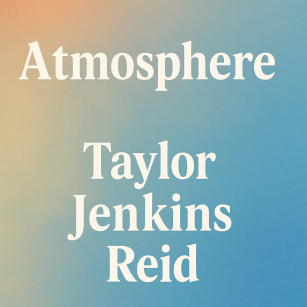Atmosphere by Taylor Jenkins Reid
BOOKS REVIEW
Chaifry
7/12/20257 min read


Taylor Jenkins Reid’s Atmosphere (2025), published by Ballantine Books, marks a bold departure from her Hollywood-centric novels like The Seven Husbands of Evelyn Hugo (2017) and Daisy Jones & The Six (2019). Set in the high-stakes world of NASA’s 1980s Space Shuttle program, this novel, a Good Morning America Book Club Pick, blends historical fiction with a tender queer love story. Centered on Joan Goodwin, an astrophysics professor turned astronaut, it explores ambition, love, and societal barriers against the backdrop of a pioneering era. Described as “thrilling… heartbreaking… uplifting” (Hannah, as cited in Reid, 2025, jacket), Atmosphere captures the spirit of trailblazers like Sally Ride and the tragedy of Christa McAuliffe, earning praise for its “excellent research and accuracy” (Weir, as cited in Reid, 2025, jacket).
Taylor Jenkins Reid, a #1 New York Times bestselling author, crafts a narrative that resonates globally with its vivid prose and universal themes. This review argues that Atmosphere is a must-read for international readers, including those in India, due to its evocative portrayal of human resilience, emotional depth, and exploration of identity, offering a lens to confront societal constraints and celebrate the courage to pursue dreams across diverse cultural contexts.
Atmosphere follows Joan Goodwin’s transformation from a reserved astronomy professor to one of NASA’s first female astronauts in 1980. Selected from thousands, Joan trains at Houston’s Johnson Space Center alongside a vibrant cohort: Top Gun pilot Hank Redmond, “always steady, even when the stars felt out of reach” (Reid, 2025, p. 34); scientist John Griffin, whose “quiet curiosity made the universe feel knowable” (Reid, 2025, p. 41); mission specialist Lydia Danes, who “carried her ambition like a shield” (Reid, 2025, p. 56); warmhearted Donna Fitzgerald, hiding “secrets softer than her smile” (Reid, 2025, p. 63); and Vanessa Ford, a magnetic aeronautical engineer whose “hands could fix an engine or break a heart” (Reid, 2025, p. 78). Joan’s passion for the cosmos drives her: “I’ve always felt the universe was calling me, not to escape, but to belong” (Reid, 2025, p. 12). Her training, from the “Vomit Comet” to mission simulations, tests her resolve.
Joan’s bond with Vanessa evolves into a clandestine romance: “Her laugh was a constellation, bright and scattered, pulling me into its orbit” (Reid, 2025, p. 102). Their love, hidden due to 1980s societal prejudices—“We’re astronauts, but on Earth, we’re still hiding” (Reid, 2025, p. 145)—complicates their professional lives. Joan’s personal life is strained by her sister, Barbara, who expects Joan to care for her niece, Frances: “Family is a tether, sometimes a chain” (Reid, 2025, p. 89). In December 1984, Joan serves as CAPCOM for mission STS-LR9, where a catastrophic spacewalk accident—“The stars were silent, but the radio screamed” (Reid, 2025, p. 201)—threatens the crew, including Vanessa. The narrative alternates between this crisis and Joan’s earlier journey, culminating in a resolution that redefines her purpose: “I am not just reaching for the stars; I am learning to live among them” (Reid, 2025, p. 287). Reid’s foreword invites reflection: “I hope Joan Goodwin can convince you to go outside tonight… and look up” (Reid, 2025, p. vii).
Atmosphere excels through Reid’s immersive storytelling and meticulous research, creating a “credible and realistic world of NASA in the 1980s” (Amazon, 2025). Her prose, lauded as “beautifully written” (Amazon, 2025), shines in vivid imagery: “The stars were silent, but the radio screamed” (Reid, 2025, p. 201). Joan’s introspective voice—“I am a prude. And always early” (Reid, 2025, p. 156)—offers a relatable yet inspiring arc, evolving from self-doubt to courage, reminiscent of Virginia Woolf’s introspective heroines in Mrs. Dalloway. The novel’s feminist perspective, capturing the “quiet, stubborn courage” of women breaking barriers (Goodreads, 2025), aligns with pioneers like Sally Ride, making it a “richly drawn page-turner” (Observer, as cited in Reid, 2025, jacket).
The queer romance between Joan and Vanessa—“Her laugh was a constellation, bright and scattered, pulling me into its orbit” (Reid, 2025, p. 102)—is portrayed with sensitivity, echoing Patricia Highsmith’s The Price of Salt. Their struggle to conceal their love—“We’re astronauts, but on Earth, we’re still hiding” (Reid, 2025, p. 145)—grounds the story in the era’s social constraints, adding emotional depth. The ensemble cast, particularly Vanessa’s complexity—“I stole money… I did too many drugs” (Reid, 2025, p. 159)—creates a vibrant found-family dynamic, resonating universally. The novel’s dual-timeline structure, weaving the 1984 crisis with training flashbacks, heightens suspense, with the “breathtaking final chapter” (Bookpage, 2025) delivering a “pitch-perfect ending” (Hannah, as cited in Reid, 2025, jacket). Reid’s research into NASA, from Apollo 1 to shuttle protocols, ensures authenticity, earning praise from Andy Weir: “Great story, excellent research and accuracy” (Weir, as cited in Reid, 2025, jacket).
The novel’s emphasis on romance—“This is a love story, not an astronaut story” (Goodreads, 2025)—may underwhelm readers expecting a space-centric narrative like The Martian. The technical space elements, while accurate, “felt almost like an afterthought” (Goodreads, 2025), with the first third overly dense: “The universe and stars… it’s nice, but not my thing” (Sam Still Reading, 2025). The subplot involving Barbara—“Family is a tether, sometimes a chain” (Reid, 2025, p. 89)—resolves predictably, lacking the nuance of the central romance, as one reviewer noted: “The subplot with Frances and Barb had me invested… more than the love story” (Goodreads, 2025).
Secondary characters, like Lydia Danes—“carried her ambition like a shield” (Reid, 2025, p. 56)—are underdeveloped, overshadowed by Joan and Vanessa. Critics argue the novel’s feminism “flatters 21st-century sensibilities” rather than challenging readers (Bookmarks, 2025), and modern phrases in a 1980s setting can feel anachronistic: “Reid’s use of modern phrases is jarring in this 1980s-set story” (Bookmarks, 2025). The title Atmosphere, while evocative, lacks clear narrative connection, unlike Reid’s more thematic titles like Malibu Rising. For international readers, the NASA-centric setting may feel niche, and the queer romance, though sensitively handled, may challenge conservative audiences in some regions.
Universal Appeal for Readers
Atmosphere is a vital read for international readers, including those in India, because its exploration of ambition, identity, and resilience transcends cultural boundaries, offering a universal narrative of courage in the face of societal constraints. Its feminist themes and portrayal of queer love provide a lens to confront systemic inequities, inspiring readers to pursue their aspirations and embrace their identities across diverse global and Indian contexts.
Joan’s journey—“I’ve always felt the universe was calling me, not to escape, but to belong” (Reid, 2025, p. 12)—captures a universal desire for purpose, resonating with readers worldwide who navigate self-doubt to achieve their dreams, from STEM professionals in Tokyo to educators in São Paulo. For Indian readers, Joan’s ambition mirrors the resilience of women entering male-dominated fields like space research at ISRO or leadership roles in Mumbai, inspiring courage against patriarchal barriers. Her evolution—“I am a prude. And always early” (Reid, 2025, p. 156)—to embracing her astronaut role reflects the struggles of Indian women in Bengaluru or Rajasthan, where societal pressures often prioritize family over individual aspirations, encouraging readers to challenge traditional roles.
The queer romance between Joan and Vanessa—“Her laugh was a constellation, bright and scattered, pulling me into its orbit” (Reid, 2025, p. 102)—offers a poignant narrative for readers navigating diverse social attitudes toward sexuality. Their secrecy—“We’re astronauts, but on Earth, we’re still hiding” (Reid, 2025, p. 145)—resonates with global experiences of marginalization, from queer communities in Berlin to those in Delhi, fostering empathy and advocacy for inclusivity. For Indian readers, this narrative aligns with evolving conversations around identity in urban hubs like Chennai or conservative regions like Uttar Pradesh, encouraging acceptance and self-expression.
The theme of familial duty—“Family is a tether, sometimes a chain” (Reid, 2025, p. 89)—speaks to international readers balancing personal ambitions with familial expectations, a common thread in collectivist cultures from India to Mexico. For Indian readers, Joan’s caregiving role for her niece mirrors the obligations of daughters in multigenerational households in Kolkata or Kerala, prompting reflection on autonomy versus duty. The NASA setting, while specific, evokes universal themes of exploration, akin to global milestones like India’s Chandrayaan missions or Japan’s Hayabusa project, inspiring readers to dream beyond local constraints, as celebrated in India’s Diwali festival, symbolizing triumph over adversity.
Reid’s depiction of workplace sexism—“Some of the men… spend most of their time cracking offensive jokes” (Reid, 2025, p. 112)—resonates with readers facing gender barriers, from corporate offices in London to tech hubs in Hyderabad. Joan’s resilience—“I am not just reaching for the stars; I am learning to live among them” (Reid, 2025, p. 287)—inspires readers to confront inequities, drawing parallels with Indian pioneers like Kalpana Chawla, whose legacy inspires women in STEM across India. The novel’s emotional climax—“The stars were silent, but the radio screamed” (Reid, 2025, p. 201)—captures the stakes of ambition, connecting with readers in high-pressure environments, from competitive exams in Seoul to corporate challenges in Mumbai.
The found-family dynamic—“Hank Redmond… always steady, even when the stars felt out of reach” (Reid, 2025, p. 34)—offers a universal message of community, relevant to readers who value collective support, from book clubs in Paris to cooperatives in rural India. The novel’s emphasis on human connection—“Life isn’t all about career milestones… it’s just as much about learning someone’s coffee order” (Reid, 2025, p. 245)—resonates with global audiences valuing small, meaningful bonds, from festivals in Rio to family gatherings in Chennai. For Indian readers, this mirrors the community-driven culture seen in festivals like Raksha Bandhan, emphasizing bonds of care. At 320 pages, Atmosphere is accessible for diverse readers, from students in Bhopal to professionals in Dubai, while its global perspective, praised as “a breathtaking, quietly staggering tale” (Heat, as cited in Reid, 2025, jacket), broadens understanding of shared human struggles. Its emotional depth and feminist narrative make it a vital text for international and Indian readers seeking stories of courage and identity.
Atmosphere by Taylor Jenkins Reid is a captivating blend of historical fiction and emotional storytelling, earning its 2025 bestseller status. Its lyrical prose—“Her laugh was a constellation, bright and scattered, pulling me into its orbit” (Reid, 2025, p. 102)—and authentic NASA backdrop create a “heart-pounding” narrative (Kirkus, 2025). Despite an overemphasis on romance and underdeveloped subplots, its feminist themes and universal resonance shine. For international and Indian readers, its exploration of ambition and identity inspires reflection on overcoming societal barriers. Highly recommended, Atmosphere is a soaring call to pursue dreams and embrace love amidst constraints.
